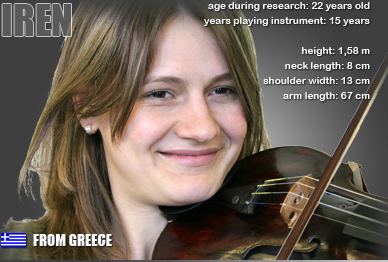4. What worked for me
I feel that playing the violin is not about just watching what you do with your eyes, but using all your senses: hearing, touch, the feeling in your joints, your balance mechanism. I needed all of these to improve my playing after the changes in equipment. Playing the violin in the dark really helped me to reorient my playing with the new equipment. In this way I could sharpen my senses and begin to make real progress.

I focused in on my sense of touch in the left hand to "find" the new, more forward, position of the fingerboard. I slid my fingers along the strings, touching each harmonic along the way, one finger at a time. I didn't press with my fingers or create tension to find the notes, but just listened. In this way I could rediscover softly the whole direction of the fingerboard under the strings, and to feel clearly how my arm moved to follow my sliding fingers through all the positions.

To reorient the bow on the string, I added more exercises like bowing with the bow directly on top of the bridge to keep the feeling of a straight bow by using the bridge as a guide. Also, every now and then, I played open strings or scales in front of the mirror to be sure that the bow was straight.
Being in a group helped a lot, because we could increase our knowledge by sharing such discoveries with each other. We also built balance boards together so that every one had one to use while practicing to help them remember their balance.
I still use my balance board every day, sometimes playing on it with a blindfold on, to help keep my senses sharp.

